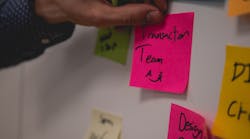Innovation is a common goal for most companies, especially in the digital economy.
According the IDC FutureScape: Worldwide Digital Transformation 2021 Predictions, "at least 30% of organizations will accelerate innovation to... future-proof their businesses" and “60% of G2000 companies will build their own business innovation platform to support innovation and growth in the new normal.”
The problem? Innovation is hard – and moving from proof-of-concept to an actual product for many organizations is often little more than a lofty goal.
“While I wouldn’t say we've totally cracked the code, you get the best results when the initial focus is on establishing cross functional buy-in. You cannot map everything out, but you can have some idea of what the value is, what good looks like, how you would bring it to the market before -- all before going down the rabbit hole of building out a prototype concept,” Andrew Cron, 84.51°’s senior vice president and chief science officer tells IndustryWeek. Owned by Kroger, 84.51° is tasked with developing data-based innovations for the retailer, its expansive supply chain as well as partner CPGs.
“Sometimes you go through that exercise and find out, this may not be the best thing to do, which gives you more resource to go after more exciting opportunities,” says Cron. “It also helps as you're going through that proof of concept to deliver something exciting to the business because the stakeholders have been there the whole time. And, if that root cause is successful, you've got the business ready to activate.”
Understandably, there is no silver bullet when seeking buy-in but being able to bring a proof of concept back to potential dollars is crucial, explains Cron. “If the ideas are squishy, you are vague time savings or the improved experience, it's really hard to get the business excited. However, improvements on top line sales or bottom-line profits quickly garner interest from business stakeholders,” he says.
Never perfect
The biggest barriers? Breaking down the walls of silos in the company and realizing not just buy-in, but also the alignment needed to move an innovation to the next level. Cron likes to break it into two parts: the first being bringing cross functional groups along from the beginning, the other being a conscious decision to embrace some of those barriers.
“By having stage gates, it pushes you to make tough decisions,” he says. “For instance, going after the things that are actually going to yield improvements rather than holding on to projects just because there is group support. The goal should be failing faster and going after the most exciting innovation areas instead of piling more and more work on unlimited resources.”
Having the right technology in place also makes a meaningful difference. For example, using a mature data science platform throughout the innovation process helps ensure that the work from initial ideation to deployment has consistency with how the product and engineering organization plans to execute.
84.51 has addressed this in part by staying on a technology journey which currently includes engaging in a deep partnership with Microsoft. “We have seen significant value from Microsoft’s cloud and data science platforms. That's not the only tool in our toolbox, but the ability to get on elastically or dynamically spin up cutting edge architectures for a project really unlocks opportunities to thrive sooner,” he says.
Measurable successes
The most natural success is a project initiated within the innovation group that makes it to the point where the proof-of-concept numbers are as anticipated. “The business gets excited when we build the product, and it works like it's supposed to,” says Cron. “Of course, in reality a lot of successes get into the squishy areas where an innovation is able to accomplish more of an intangible goal that a department or customer subset desired.”
According to Cron, improving the innovation process needs to be about creating better visibility for stakeholders. “We are all trying to stay competitive and being able to give our innovators the freedom to go out and search for exciting opportunities, while showing internal investors the value potential is growing increasingly important,” he says.
Opportunities also exist to continue automating decision making. “It takes a lot of people to run an organization, and each person is doing the best to make decisions which often leads to making more and more decisions,” he says. “Using artificial intelligence, machine learning can automate this process. It's not like we need to always take the human out of the loop, but even giving people the right tools at their fingertips to make better decisions more quickly, could pay significant rewards.”



